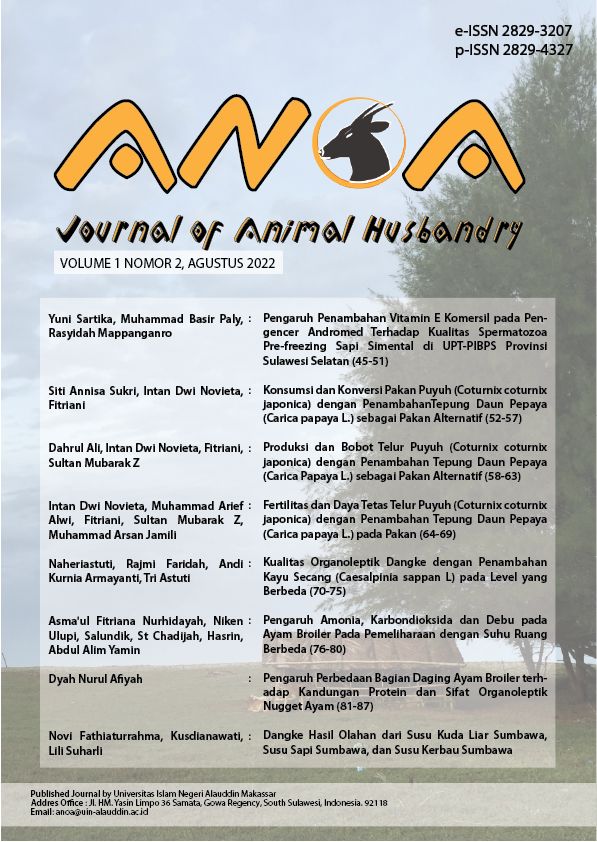Pengaruh Amonia, Karbondioksida dan Debu pada Ayam Broiler Pada Pemeliharaan dengan Suhu Ruang Berbeda
The Effect of Ammonia, Carbon Dioxide, and Dust of Broilers Farming with Different Room Temperature
Abstract
This study aims to study the impact on Maintenance broilers of temperature differences on ammonia, carbon dioxide, and dust. The completely randomized design (CRD) was used for the experiment design, with temperature of 20oC (KS20) and 30oC (KS30) as treatments. The experiment was repeated four times and each replication contained of 10 chickens. The ammonia, carbon dioxide, and dust sample was taken three times, at the 3rd, 4th, and 5th week of the experiment. Ammonia concentration during the 4th week was 0.08 ppm and increased to 2.022 -2.027 ppm at the 5th week; the carbon dioxide concentration at low temperature and high temperature was increased 17.76-22.13 ppm at the 5th week. The total dust increased at the 5th on the low temperature condition. The conclusion of this study, broilers were maintained at high temperature (30oC) produced lower air quality, in conditions this indicate that the broilers environment with conditions reared at high temperatures is still in a good condition.
Downloads
References
Ajakaiye, J.J., Alcides, P.B., & Angel, M.T. (2012). Effects of high temperature on production in layer chickens supplemented with vitamins C and E. Revista MVZ Cordoba, 16 (1), 2283-2291.
Bell, D.D., & Weaver, W.D. (2002). Commercial chicken meal and egg production. Ed. .. ke-5. New York: Springer Science Bussiness Media.
Badan Pusat Statistika. (2017). Suhu minimum, rata-rata, dan maksimum. https://www.bps.go.id/statictable/2017/02/09/1961/suhuminimum-rata-rata-dan-maksimum-di-stasiun-pengamatan-bmkg-oc-20112015.html.
Calvet, S.H., Van den Weghe, Kosch, R., & Estelles, F. (2009). The influence of the lighting program on broiler activity and dust production. Poultry Science, 88, 2504- 2511.
Calvet, S., Estelles, F., Cambra L.M., Torres, A.G., & Van den Weghe, H.F.A, (2011). The influence of broiler activity, growth rate, and litter on carbon dioxide balances for the determination of ventilation flow rates in broiler production. Poultry Science, 90, 2449-2458.
David, B., Moe, R.O., Michel, V., Lund, V., & Mejde, C. (2015). Air quality in alternative housing systems may have an impact on laying henwelfare. Part I-Dust. Journal animals, 5, 495-511.
Ensminger, M.E. (1992). Poultry Science (Animal Agricultural Series). 3rd Ed. Illionis: Interstate Publishers, Inc. Danville.
Fairchild, B. (2012). Environmental factors to control when brooding chicks. Cooperative Extension Bulletin 1287, Georgia. Hal. 1-5.
Garces, A., Afonso, S.M.S., Chilundo, A., & Jairoce, C.T.S. (2013). Evaluation of different litter materials for broiler production in a hot and humid environment: 1. Litter characteristics and quality. J applied Poultry Research, 22, 168-176.
Jentsch, W., Piatkowski, B., & Derno, M. (2009). Relationship between carbon dioxide production and performance in cattle and pigs. Archives Animal Breeding, 5, 485-496.
Karaman, S. & Gokalp, Z. (2017). Indoor air quality in animal housing systems (gas, odor and dust). National Science, 6 (12), 67-271.
Li, H., Wen, X., Alphin, R., Zhu, Z., & Zhou, Z. (2017). Effects of two different broiler flooring systems on production performances, welfare, and environment under commercial production conditions. Poultry Science, 96, 1108–1119.
Naseem, S. & Annie, J.K. (2018). Ammonia production in poultry houses can affect health of humans, birds, and the environment—techniques for its reduction during poultry production. Environmental Science and Pollution Research, 25, 15269–15293
Ostovic, M., Mencik, S., Ravic, I., Zuzul, S., Pavicici, Z., Matkovic, K., Antunovic, B., Tomic, D.H., & Kabalin, A.E. (2017). Relation between microclimate and air quality in the extensively reared turkey house. Macedonian Veterinary Review, 40 (1), 83-90.
Paulson, S., Brain, S., & Rick, V.K, 1999. Management of dust in broiler operation. BCMAF.https://www2.gov.bc.ca/assets/gov/farmingnaturalresourcesandindustry/agricultureandseafood/farmmanagement/structuresandmechanization/300series/3842009management of dust in broiler operations.pdf.
Ritz, C.W, Fairchild, B.D. & Lacy, M.P. (2004). Implications of ammonia production and emissions from commercial poultry facilities: a review. Journal Applied Poultry Research, 13, 684-692.
Ritz, C.W., Fairchild, B.D., & Lacy, M.P. (2009). Litter quality and broiler performance. Cooperative Extension Bulletin, Georgia. Hal. 1-7.
Scanes, G.S., & Christensen, K.D. (2020). Poultry Science. USA: Waveland Press Inc.
Standar Nasional Indonesia. (2004). Pengukuran kadar debu total di udara tempat kerja. Standar Nasional Indonesia, 16-7058.
Standar Nasional Indonesia. (2005). Emisi gas buang. Sumber tidak bergerak. Bagian 6: cara uji kadar amoniak (NH3) dengan metoda indofenol menggunakan spektrofotometer. Standar Nasional Indonesia, 19-7117.6.
Standar Nasional Indonesia. (2005). Emisi gas buang. Sumber tidak bergerak. Bagian 10: cara uji konsentrasi CO, CO2, dan O2 dengan peralatan analisis otomatik. Standar Nasional Indonesia, 19-7117.10.
Stenzela, A.K., Witkowska, D., Janina, S.J. & Stopyra, A. (2017). The effect of stable bedding materials on dust levels, microbial air contamination and equine respiratory health. Research in Veterinary Science, 115, 523-529.
Ulupi, N., Afnan, R., & Rukmiasih. (2016). Level of ammonia, dust, production performance, and egg quality of laying hens on cage and litter system in tropical area. IJSBAR 30, 339-348.
Vucemilo, M., Matkovic, K., Vinkovic, B., Jaksic, S., Granic, K., & Mas, N. (2007). The effect of animal age on air pollutant concentration in a broiler house. Czech Journal Animal Science, 52 (6), 170-174.
Vucemilo, M., Matkovic, K., Vinkovic, B., Macan, J., Varna, V.M., Prester, L.j., & Granic, K.T.O. (2008). Effect of microclimate on the airborne dust and endotoxin concentration in a broiler house. Czech Journal Animal Science, 53 (2), 83–89.


